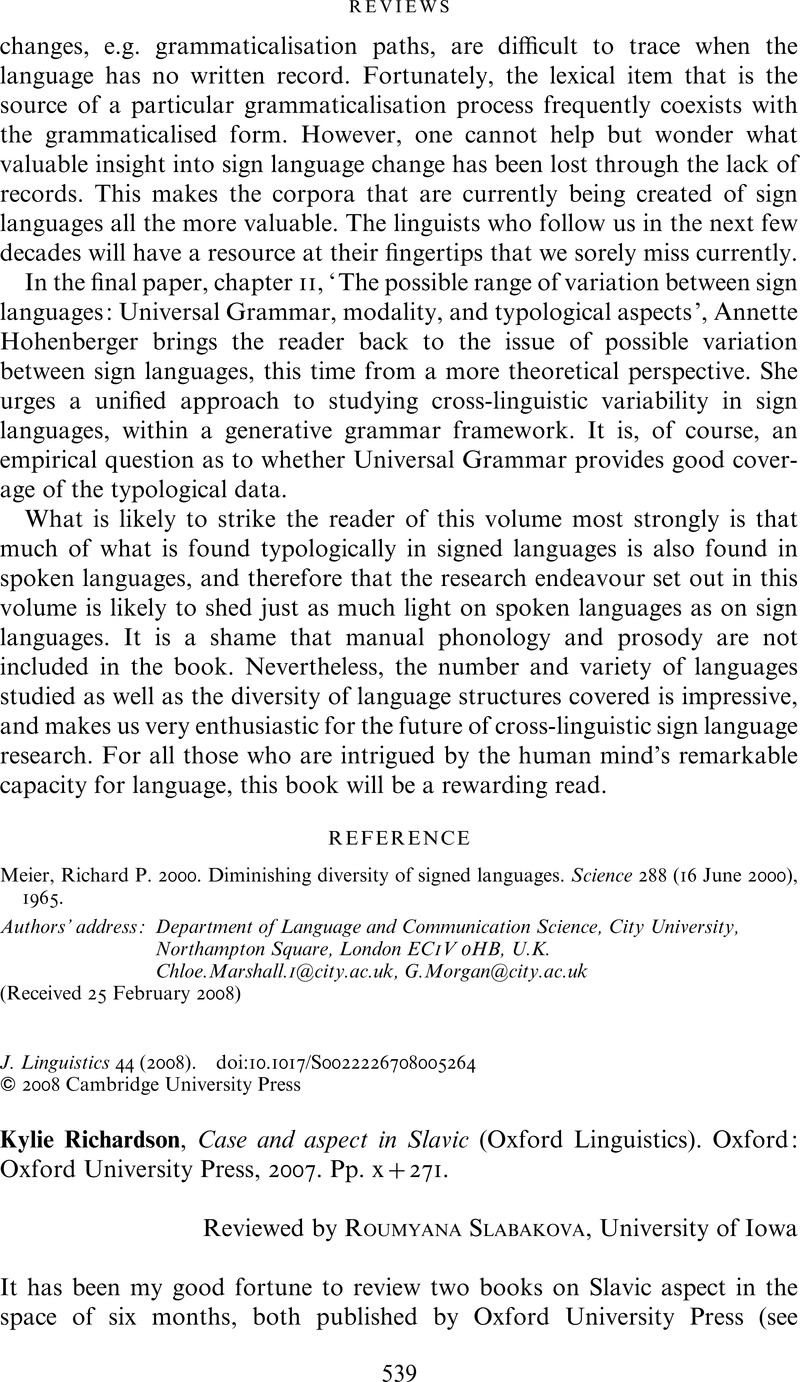No CrossRef data available.
Article contents
Kylie Richardson, Case and aspect in Slavic (Oxford Linguistics). Oxford: Oxford University Press, 2007. Pp. x+271.
Review products
Kylie Richardson, Case and aspect in Slavic (Oxford Linguistics). Oxford: Oxford University Press, 2007. Pp. x+271.
Published online by Cambridge University Press: 19 June 2008
Abstract
An abstract is not available for this content so a preview has been provided. Please use the Get access link above for information on how to access this content.

- Type
- Reviews
- Information
- Copyright
- Copyright © 2008 Cambridge University Press
References
Bohnemeyer, Jürgen & Mary, D. Swift. 2004. Event realization and default aspect. Linguistics and Philosophy 27.3, 263–296.CrossRefGoogle Scholar
Borer, Hagit. 2005. Structuring sense, vol. 2: The normal course of events. Oxford: Oxford University Press.CrossRefGoogle Scholar
Borik, Olga. 2006. Aspect and reference time. Oxford: Oxford University Press.CrossRefGoogle Scholar
Brecht, Richard D. 1985. The form and function of aspect in Russian. In Michael, Flier S. & Richard, Brecht D. eds. Issues in Russian morphosyntax, 9–34. Columbus, OH: Slavica.Google Scholar
Chomsky, Noam. 2001. Derivation by phase In Michael, Kenstowicz (ed.) Ken Hale: A life in language, 1–52. Cambridge, MA: MIT Press.Google Scholar
Dickey, Stephen. 2000. Parameters of Slavic aspect: A cognitive approach. Stanford, CA: CSLI Publications.Google Scholar
Dowty, David R. 1979. Word meaning and Montague Grammar: The semantics of verbs and times in Generative Semantics and in Montague's PTQ. Dordrecht: Reidel.CrossRefGoogle Scholar
Filip, Hana. 1999. Aspect, eventuality types, and nominal reference. New York & London: Garland.Google Scholar
Filip, Hana. 2005. The telicity parameter revisited. Semantics and Linguistic Theory (SALT) XIV, 92–109.Google Scholar
Hout, Angeliek van. 2007. Acquiring telicity crosslinguistically: On the acquisition of telicity entailments associated with transitivity. In Melissa, Bowerman & Penelope, Brown (eds.) Crosslinguistic perspectives on argument structure: Implications for learnability, 255–278. Hillsdale, NJ: Lawrence Erlbaum Associates.Google Scholar
Pesetsky, David & Torrego, Esther. 2007. The syntax of valuation and the interpretability of features. In Simin, Karimi, Samiian, Vida & Wilkins, Wendy K. eds. Phrasal and clausal architecture: Syntactic derivation and interpretation, 262–294. Amsterdam & Philadelphia: John Benjamins.CrossRefGoogle Scholar
Schoorlemmer, Maaike. 1995. Participial passive and aspect in Russian. Ph.D. dissertation, Utrecht University.Google Scholar
Slabakova, Roumyana. 2007. Review of Olga Borik, Aspect and reference time (2006). Folia Linguistica 41.3/4, 455–460.Google Scholar


